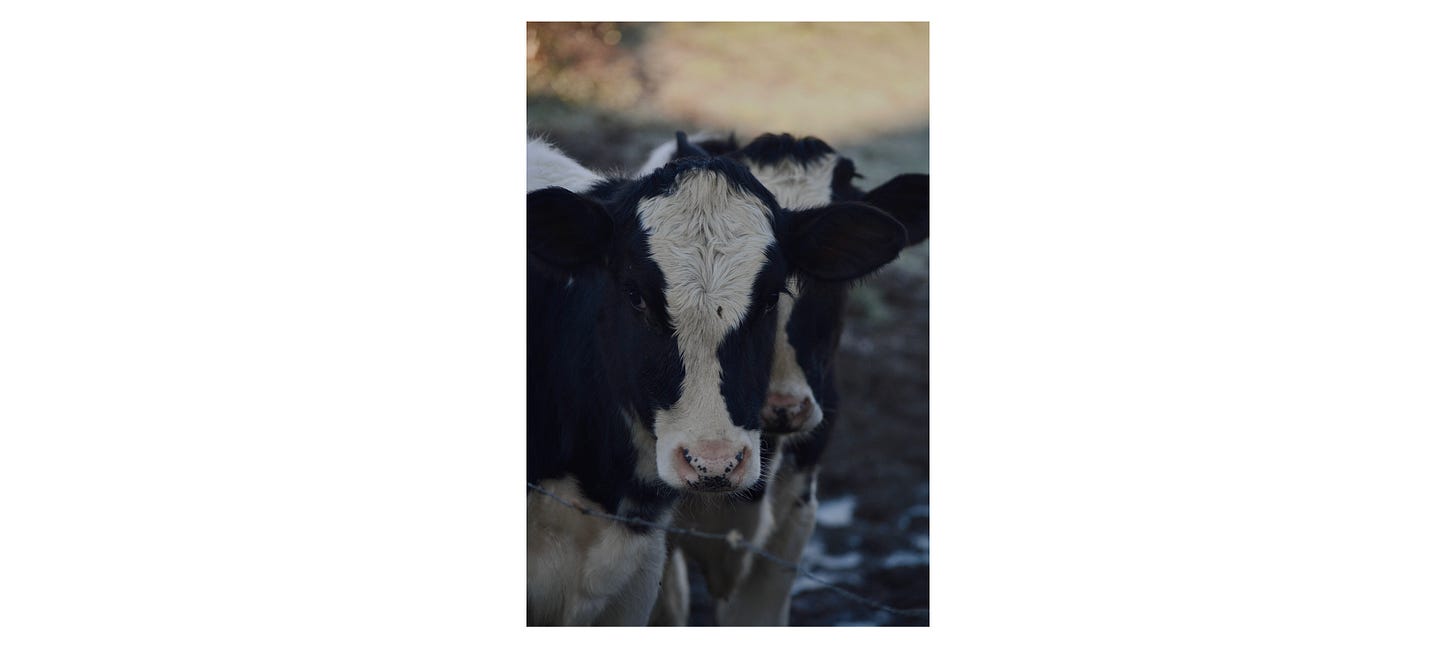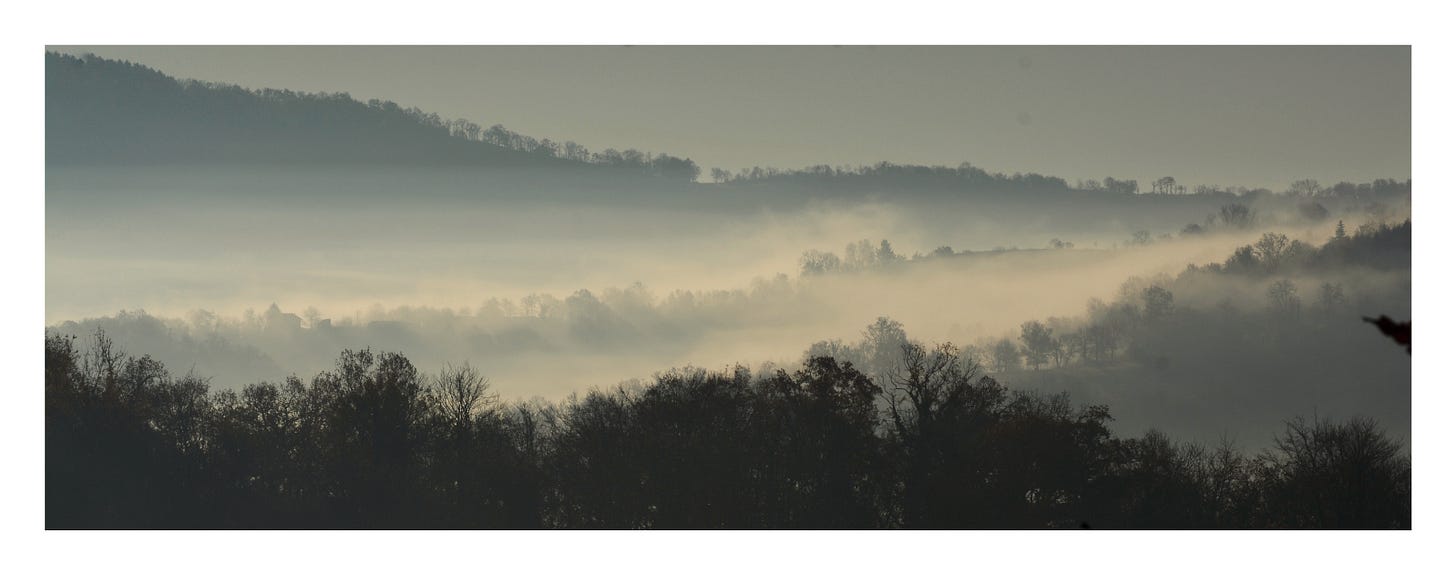A hill and I - Autumn
Part 3 - every malingering breath of warmth is carried away in the wind.
Dearest friends, readers, writers, curious newcomers, I am delighted and filled with gratitude that you are here, sharing a few moments of your time with me.
A huge and heartfelt thank you for returning for this, the third of four letters exploring the paths and terraces, flora and fauna, traditions, beliefs and remedies on and surrounding the hill I live on - a wilderness of past and present entwined in seasonal change.
For those of you who are new to A hill and I and would like to (t)read the paths of Spring, and Summer you’ll find a link at the bottom of the page for both and for those who may, like me, have read so many other incredible pieces of writing on Substack Writers since that you know you’ve read them but can’t remember what the devil I’m taking about , here is a recap;
The outline of the project very briefly:
I was invited way back in December 2023 to guest write a post for Alexander M Crow, an offer I accepted with an equal dose of surprise and pleasure.
Alex asked this;
“discuss a walk you take around where you live, as seen from the perspective of nature observation and through the eyes of our hunter-fisher-gatherer ancestors.”
I have concentrated less on the hunter/fisher than the gatherer and, in this Autumn edition, the finder of paths — I hope you enjoy my Equinox walk.
If you would like to read the original post from Alex, you will find it here.
“To apprehend things—walking on a hill, seeing the light change, the mist, the dark, being aware, using the whole of one’s body to instruct the spirit—yes, that is a secret life one has and knows others have. But to be able to share it, in and through words—that is what frightens me ... It dissolves one’s being…” — Nan Shepherd
Autumn Equinox - September 22 - 2024, 2:43 PM
そよ風 (Soyokaze) meaning a slight breeze in Japanese, or breath of air, a zephyr - in Autumn you could touch a word like that…
Without a backward glance, the warmest of seasons has turned to our opposite side to warm different trees and different oceans and whole other continents and their people. Soon, the hill will be alight with colour and the erotically sensuous scents of moss and fungi and leaf decay as the land prepares for winter sleep.
Autumn; the season that ambles so gently through our days with its calming yet preparative caress of cool breezes, misty mornings and still warm evenings as summers honeyed horizons fade into silhouette and more unsettled skies. Leaves in windswept drifts, are swept up in the hustle and bustle of gathering apples and pears, hops and hips and haws, preparing and preserving. There is much to think about and more to do.
Summer departs, unusually, with the last day of August this year — not gently but with a hoot of laughter — every malingering breath of warm air was carried away in winds from the North chilling all things living to such a degree as to fool them; which season has been sent in its place? A flurry of cold days see me watching as every fruit left ripening, teetering on its life giving branch, falls to sodden ground and I know, now, any race with time is already lost. I watch helplessly as too many kilos of fruit return to earth. I hurry to gather hops1 from the hedges to add to sleep pillows already filled with lemon balm, I fill jars to make hop tea for controlling cholesterol and — though I fear I am already many years too late — this year I will experiment with a balm and a remedy2 to help delay premature ageing — yes I’m smiling too.
Regardless of my succeeding or not, wild animals will forage and feast well on much fallen abundance this autumn.

I diverse, distractions on my hill are plentiful in autumn.
The now leaf strewn paths are passable but with difficulty after the humidity of a cold, wet summer. Often, not wishing to be encumbered with tools for clearing a way ahead, I am forced to return, retracing steps in search of an easier route, wondering how in centuries passed our ancestors managed to keep these intricate, often arduously steep, mazes of connectivity open and navigable, how they continued to use them through this and the season to follow. This work of hand would have been constant to enable easy passage for both human and animal. Evidence of ancient roads running from hamlet to hamlet run to the sides and through many of the woodlands; scattered stones unearthed by the feet of cattle from man laid cobbles, a stone wall to mark its boundary, a double line of trees running beside a meadow. Now, so infrequently touched by human footfall, nature re-wilds them with no thought for the stories of the many thousands of feet already passed.

Only the cattle trails are visible across the meadows. The crops and wild growth all cut for hay in readiness for winter leave the pastures fallow. It is one of the few traditions that hold fast enabling these paths and tracks to be easily traced, crisscrossing the hill with — apparently — no design or destination except where ending at a watering hole. Many of these meadow paths filter into forests and woodland, these are wild trails, sporadically tracking through dense undergrowth and low branches, clandestinely they disappear and reappear, they lead nowhere and everywhere. I lose many hours following narrow woodland tracks, under and over branches, across streams they wind and falter and so often they are no more. These are the hunters paths. These are the paths guarded by families for centuries, have been kept secret and relied on for foraging food, both animal and vegetable for giving as gifts and for celebrating with festivals and great feasts in thanks for a bountiful harvest. These are paths I spend delirious hours of stumbling — often literally — on well cloaked secrets in dense woodland foliage. Lairs and latrines where badgers roam, winter stores, a tidily stacked tiny mountain of hazel and beechnuts at the base of a tree, a lovingly and carefully stuffed cushion of dried grasses and soft moss in a dead stump. I watch, intrigued and amazed a dragonfly lay its eggs by the side of a stream safely incubating until spring. It is here, on these paths that hold the secrets of hunter gatherers since humans first walked the land, paths guarded preciously by families for centuries, that I discover the mystery of where the mushrooms grow.

We are inextricably tied to fungi, they are evolutionary marvels, the silent, unsung, conquerers of our planet. Mushrooms have touched our curiosity since the very dawn of time, are ever evolving, have been steeped in mystery for eons, they like to listen to songs, and thunder, being struck by lightening can stimulate frantic mycelia growth - mushrooms truly are magic…
It is no wonder mushroom hunting is a century old national pass-time the length and breadth of France. After hot summer storms and gentle September rains, so idillic for germinating spores, magical carpets of wild fungi appear in fields and on forest floors alike tempting whole families armed with baskets — never place your mushrooms in plastic —and knives — the debate on whether to pick or cut is ancient and eternal — out into fresh autumnal air.
Soon, chestnuts will join falling leaves to carpet the lanes and paths, I will hear wild boar in the night, their many cloven feet pattering along the lanes under a full harvest moon, followed by strong jaws grunting with the joy of rapturous feasting — spiny bogs a skilfully removed inconvenience — abundant chestnuts will be eaten noisily — imagine a Roman banquet —and plentifully for fattening and strengthening before the sparse winter months ahead. If I am fortunate they will leave me enough to make flour. Too often they don’t, the nuts disappear with the boar, only the prickly bogs laying as empty evidence.
And, as it does with each season, autumn too will delight every sense with its festival of food and carnival of golds then fade into the decaying leaves of the next to leave me shivering in only the bare bones of winter…
There is no time for lament.
Of Autumn Hare…
Chill in breeze — autumn ruffling black tipped ears
twitching nose catches scents - musty moss, beginnings of decay.
deer began rutting,
he knows, he is listening
ears, black tipped, alert, hear all
tap, tapping antlers ring through the forest
(two cycles of moonlight passing)
swifts and swallows, he sees their tails
lining lines, human lines
(they are brave and strong - all birds are brave)
he knows not of destinations but his own,
they fly through sunbeams
and they return
accompaniment to his silence
ears, black tipped, alert, hear all
a sigh, leaf falling, breeze calling
movement only second to sound.
wise eyes, watching
winter moths flitting
faded flower to faded flower,
yarrow, wild carrot, hyperricum
(fine bones)
visible now great sun is less
autumn trailing frayed edges...
twitching nose catches scent of woodsmoke - the beginnings of closing
(humans preparing)
and, hill forest is calling,
he knows he must return.
he knows hill waits
cold earth nigh, damp air chills
better a bitter wind, ruffling soft fur
white flecked, he leaps
twitching nose catches scent of snow - the beginnings of winter...
and is gone.
“A person susceptible to "wanderlust" is not so much addicted to movement as committed to transformation.”
― Pico Iyer
With golden autumn tapping at my door I send you love…
A hill and I - Summer
Dearest friends, readers, writers, curious newcomers, as always, I am delighted you are here sharing a few moments of your time with me.
A hill and I - Spring
Dearest friends, readers, writers, curious newcomers, as always, I am delighted you are here sharing a few moments of your time with me.
Hops; Humulus lupulus, is a climbing plant and part of the Cannabaceae botanical family.
Etymology: The botanical name "lupulus" comes from the Latin meaning "little wolf". This name reflects its tendency to smother the trees it wraps around, depriving them of light. This comes from the Roman idea that hops parasitized the trees it climbed, similar to a little wolf feeding on their sap.
Hops are a powerful antioxidant: protecting our cells against the damage of free radicals, as well as being having calming effect to agitation and encouraging sleep,












Love this -- the capturing of place and season is wonderful -- textured and immersive
Yet another exquisite feast of words, Susie. You weave spells with your writing, truly.